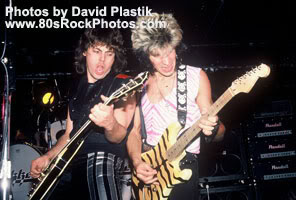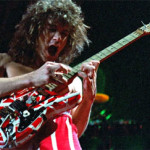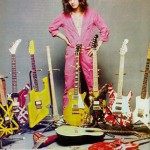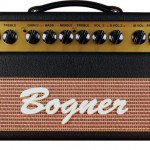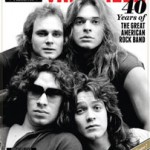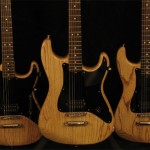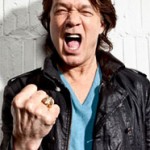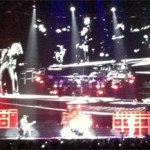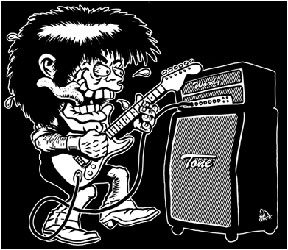George Lynch’s ‘Breaking the Chains’ Gear
George Lynch is one of my favorite guitarists, but for guitar fans he seems to be a love him or hate him guy – no middle ground.
Maybe that’s because he has a distinctive style, and he’s very experimental having tried the rock-rap thing (I love the Smoke This CD), entire albums and concerts with baritone guitars, and just about every amp and piece of gear ever created.
That, along with George’s style and relentless pushing of himself, is what makes him so fun – for me and a lot of other people, anyway. And let’s not forget that in the early ’80s, the three major guitar-slingers to come out of the west were George, Randy Rhoads and EVH. So Lynch is a forefather!
While George has always been one to experiment, back in the day there just wasn’t as much to experiment with. And though he has consistently pushed for “gainier” sounds, back in 1981 – when I believe Dokken’s first album Breaking the Chains was recorded – there wasn’t that much gain to be had, even though everyone kept trying for more (boosting Marshalls, and using higher-output pickups and even early distortion boxes).
So here is George’s Breaking the Chains gear, in his own words (give or take) – from his oft-changing website. The “Gear” pages on the current site are under construction, but using the way back machine you can see the Breaking the Chains studio and live gear.
Studio
“The Breaking the Chains record was such an adventure. We flew to Iceland and I had my Tiger wrapped in a blanket and duct tape. All the finish checked on it on the trip over because the paint was so fresh. It acquired a lifetime of character overnight! I also brought my favorite Marshall and my old gray tube Echoplex, and my AD/A flanger with me.”
Recording in the basement of Dieter Dierks B studio in Germany, George put [his] old gray Echoplex back together. “It was out of a box and a bunch of parts that I had strewn together on the floor,” he said. He used this Echoplex as part of his preamping…going into a ’71 Marshall Super Lead.
He swears that Marshalls sound better in Europe due to being manufactured to run at 220 volts. With the sound generated through a Marshall Super 100 4×12 cabinet with the cane basket weave grille, he recalls how [pure] the sound was. “Marshalls want to run at 220V. That what they were designed for. When I think about that, every time I toured Europe, I liked the way my amps “breathed.'”
Also used to goose the input of the amp was a Dallas Rangemaster Treble Booster similar to what Ritchie Blackmore and Jimmy Page [and many other artists, including Tony Iommi] used back in the day.
“I used my tiger [M1], which had a quibki neck [?] on it at the time and my old homemade ‘flying tiger.’ That guitar found its way to Warren DeMartini eventually and he still asks me about it to this day. We have no idea where it ended up but would like to find it someday.
> Here’s some interesting info about the Breaking version of the Tiger, according to George’s old website: “The original Tiger [body was] built by George and Carl Sandoval in ’79 out of one large block of solid maple. [It was] originally fitted with a quebiki maple boat neck with ebony fretboard and “hooker” headstock, which eventually twisted during the recording of the Breaking the Chains album in Germany. It was replaced with a Boogie Bodies quarter-sawn 1 3/4″ maple/maple neck [don’t know if this was on purpose or not, but this was just like the one Eddie Van Halen had on the Frankie at one point]. Bridge is a Floyd with Kahler locking mechanism to retain string [tension] across nut.”
> I could not find any definitive info about the Tiger’s original pickup. I’m not sure if the Duncan Distortion was in production yet, which would mean that the only “distortion” pickup available was the DiMarzio Super Distortion – or was it? Take a look at the video below, from 1982. That appears to be Tiger guitar with the original neck, and the pickup, which you can see best at 2:39, is what? A Bill Lawrence?
> It’s a good bet that the above was similar to George’s pre-Breaking live rig, maybe minus the iffy-sounding Echoplex. But figure it was a boost into a Marshall. That’s what the better players looking for “more” were doing at the time.
> Recording-wise, George said: “We used an Old MCI 400 board and a beautiful old Telefunken tube 24-track machine. Old stuff is cool!”
> He also had these two stories: “Rory Gallagher was working in the studio and he would come in between dart games and rounds at the pub and just hang. I was a little nervous with him around but he was always encouraging me, complimenting me and building my confidence. The Scorpions were also in the studio upstairs working with Dieter. They were doing the Blackout album and they always needed to check with us Americans because they weren’t sure if they lyrics were making sense in English. We shouldn’t have bailed them. Some of that sh*t was hilarious…not that the Dokken lyrics weren’t just as ridiculous.”
Tour
After the album came out, George toured the U.S. with the new Randall solid state amps that he would then use on Tooth and Nail. In 1984 George said: “I’m using four Randall RG-80 heads and four Randall cabinets with 65-watt Celestions. They just kill.
“I go through amps like water and I’ve been through every amp in the book. I was blown away by the Randalls.”
George worked with Gary Sundow, the chief engineer at Randall R&D, and came up with the 80 and then the 100. “We were basically just scoping and emulating old Marshalls, and then tweaking them,” George said.
George split the set up on either side of the stage, two on each side of the stage to fill up the sound. To split the signal, he used a Boss CE-3 Stereo Chorus. To push the guitar’s signal harder into the input of the Randall heads, a Boss OD-1 was employed.
Here we also see the beginnings of a more sophisticated live Lynch-tone with the use of a Lexicon PCM-41 (sometimes a Roland 301 Chorus Echo). He used this to have a wider, bigger and truer stereo effect by having two heads running dry and two heads with echo.
At one point George actually had 10 loaded Randall 4×12 cabs and 10 Randall RG-100 heads on stage, but what was miked was a Randall RG-80 combo amp on a chair behind his wall-o-amps.
> Don’t know if this one is true or not [George seems to have a subtle sense of humor], but George also had this on his old website: “When George showed up for taping of Dick Clark’s American Bandstand TV show in ’85, he had Randall make him folding dummy cabs that actually had pictures of speakers to simulate actual speaker cabinets. ‘I could fit 10 stacks in my trunk,’ bragged George.”
Dokken, Breaking the Chains, Live in Germany, 1982
Category: Echoplex, George Lynch, Marshall, Randall Amplifiers, Rangemaster

